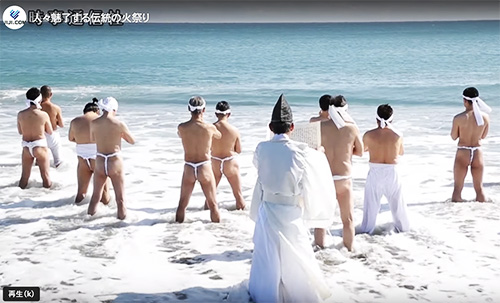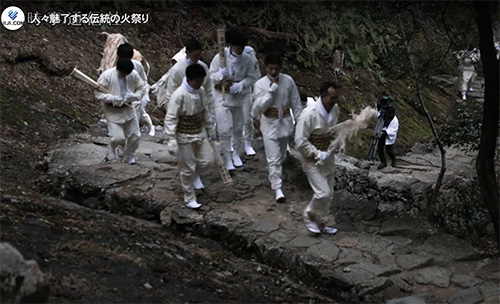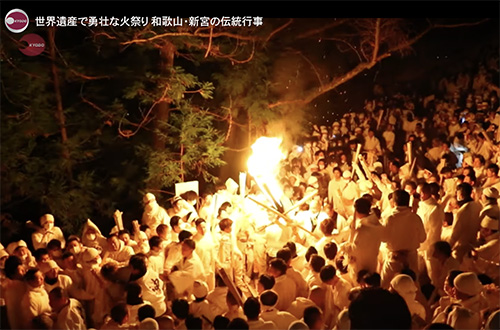


日本の祭りでは、各地で「神奈備」のひとつとしてまことに勇壮な神事が執り行われる。そういったひとつとも思えるけれど、この新宮・神倉神社の奇祭の危険度は非常に高い。これら火祭りの画像は一般社団法人 共同通信社が配信しているKYODO NEWSの動画から静止画としたもの。
カミと一体化するために多くの人びとは身を清め、相当の覚悟を持って神事に参加する。毎年2月6日に行われるということで、花の窟神社の御綱祭事が2月2日であることと関係するように思える。実際にこの奇祭の趣旨として、旧暦での新しい年の新しい「火」を里人の家に送り届けるというような共同体社会としての意味があるのだという。
花の窟神社で祭神として祀られた軻遇突智(カグツチ)は「火の神」としてイザナミが産んだけれど、その時の火傷でイザナミが命を落とした。そのときにカグツチも花の窟神社に葬られたとされるけれど、しかし火は人間社会にとって絶対必要欠くべからざる存在。そこで花の窟神社の神体と類似したこのゴトビキ岩から火の神が駆け下りるという神意をまつりごととして実現させたように想像できる。
神事に当たって参加者たちは海辺で神体を清め、神主さんに御祓いをして貰い、白装束に身を固めて固く決意をもって急峻な参道を上ってゴトビキ岩に向かう。

北海道ではこういった伝統的神事はあまりない。明治以降、全国から分散的に移住してきた人びとが無縁性の高い社会を作り始めてからまだ150年ほどであり、こうした神奈備風習は多くない。対比的に熊野のような地域社会では習俗が連綿と繰り返され、それが地域のアイデンティティとして成立し続けている。
列島社会としてはこうしたものが継続され続ける社会の精神性基盤があるということ。地域の生き方に強く関わっていて、個人を超える「公共」という意識を強く涵養し続けたことだろう。
こういった神奈備へのリスペクトを基盤とした社会というものはどのような精神を育んでいくか。なりわいを中心にして形成される地域毎の「ムラ」社会が、こういった機縁を共同体のおおきな結束根拠として活用していくことは自然だったことだろう。
そういった強い共同体意識はムラ同士の間では、ある緊張関係をもたらして、非常に分権的な社会構造が出来上がっていくことが容易に想像できる。島嶼地域アジアで強い王権や政体が出現しにくかったことと、やや北方に位置するこの日本列島社会の底流とは、類縁性が高いと思われる。
そういったなかにも関わらず、いわばゆるやかな王権を確立させた日本の皇統は、各地に残るさまざまな地域的統合説話と丹念に向き合って、説話レベルでの「統合」を図っていったのではないだろうか。天武帝と舎人親王は地道な各地域の説話に整合性を与えていく困難な作業を厭わず、日本書紀・古事記を成立させて世界最長の皇統の歴史を築いていったように思われる。
English version⬇
The “God of Fire” who runs down in the Fire Festival: The Myth of the Imperial Lineage and the Kumano Journey-27
A decentralized society unified by the “matsuri goto” culture of the Mura unification. The cultural policy of the Japanese imperial lineage, which made efforts to be consistent with such a reality. …
In Japan, many festivals are held in various places to perform truly heroic rituals as one of the “kannabis”. Although it seems to be one of those, this strange festival at Kamikura Shrine in Shingu is very dangerous. These images of the fire festival are stills from the KYODO NEWS video distributed by Kyodo News.
In order to become one with Kami, many people purify themselves and participate in the ritual with considerable determination. The fact that the festival is held every year on February 6 seems to be related to the fact that the Gozuna ritual at Hana-no-Kutsu Shrine is held on February 2. In fact, the purpose of this strange festival is to send a new “fire” for the new year in the lunar calendar to the homes of the villagers as a communal society.
Kagutsuchi, the Kagutsuchi enshrined at the Hana no Kutsu shrine, was the “fire god” and was born to Izanami, but Izanami lost her life due to a burn at that time. Kagutsuchi is said to have been buried at the shrine of Hana-no-Kutsu Shrine, but fire is an absolute necessity for human society. It can be imagined that the divine intention of the god of fire running down from Gotobiki Rock, which is similar to the sacred body of the Hana-no-Kutsu Shrine, was realized in the form of a festival.
Participants in the ritual purify the body of the god on the beach, have it purified by the priest, and then, dressed in white, walk up the steep path to Gotobiki Rock with firm determination.
There are not many of these traditional Shinto rituals in Hokkaido. It has only been about 150 years since the Meiji period (1868-1912), when people dispersedly immigrated from all over Japan and began to create a highly unrelated society, and there are not many such kannabi-style customs in Hokkaido. In contrast, in local communities such as Kumano, customs have been continuously repeated and have continued to be established as a local identity.
This means that the archipelagic society has a social spiritual foundation that continues to sustain these customs. They are strongly related to the local way of life and continue to cultivate a strong sense of “publicness” that transcends the individual.
What kind of spirit will be fostered in a society based on this kind of respect for Kannabi? It would have been natural for the local “mura” society, which is formed around the community’s “nari-wari,” to utilize this kind of opportunity as a basis for community cohesion.
Such a strong sense of community would have brought about a certain tension between the mura, and it is easy to imagine that a very decentralized social structure would have been created. The fact that strong kingships and political systems were difficult to create in island Asia and the underlying currents of society in the Japanese archipelago, which is located slightly to the north, seem to have a strong similarity.
The Japanese imperial lineage, which established a loose royal authority in spite of such circumstances, may have worked to “unify” at the level of legend by carefully examining the various regional unification legends that remained in various regions. Emperor Temmu and Prince Shonin seem to have established the history of the world’s longest imperial lineage by establishing the Nihonshoki and Kojiki through their willingness to go through the difficult task of bringing consistency to the various regional legends.
Posted on 1月 31st, 2024 by 三木 奎吾
Filed under: 日本社会・文化研究







コメントを投稿
「※誹謗中傷や、悪意のある書き込み、営利目的などのコメントを防ぐために、投稿された全てのコメントは一時的に保留されますのでご了承ください。」
You must be logged in to post a comment.